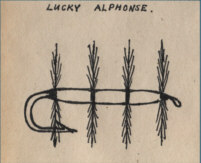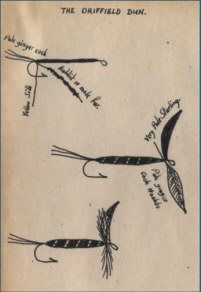Favourite Flies for the River Clyde (continued)
"FIREFLIES" that kill at Dusk
LEADED FLUORESCENT SPIDER
Hook:
Size 8
Tail:
Short piece of arc chrome fluorescent wool at dusk, or signal
green after dusk
Body:
Peacock herl dressed flat with lead wire beneath
Hackle:
Black hen
TONY'S NYMPH
Hook:
Size 12
Tail:
Few fibres of cock pheasant tail
Body:
Mixed dubbing of claret seal's fur and clipped fire-orange
fluorescent wool
Rib:
Fine round silver tinsel
Hackle:
Small, sparse black hen
CLIPPED BUTCHER
Hook:
Size 12
Tail:
Short stump of fire-orange fluorescent floss
Body:
Silver tinsel
Head:
Black ostrich herl
LUCKY ALPHONSE
| This fly has four cream hackles, the body
material is undyed swan herl and the tying silk is dark brown. This silk is
allowed to show a little on each side of each hackle. The hook size is 12
longshank. The fly is fished dry but it should not sit high on the water but
rather in the surface film. |
 |
THE DRIFFIELD DUN
|
This is a Yorkshire dry fly and it should
be dressed sparsely to give the best results.
Tail:
Two or three pale ginger cock hackle whisks
Body:
Pale rabbit's or mole's fur, either lightly dubbed on to yellow
silk so that the silk shows through the fur or with the fur put on first and
ribbed afterwards with a piece of unwaxed yellow tying silk. If you use a
minimum of fur to give the fly a very slender body, you can then use the yellow
thread to rib it carefully and neatly to produce an attractive looking body for
the fly.
Wings:
Slender strips of pale starling, and these are tied forward,
toward the eye of the hook
Hackle:
Pale ginger cock hackle
|
 |
THE HATCHING OLIVE
Hook:
Size 13 to 16
Tying silk:
Brown
Body:
Olive green condor or similar. Use three fibres and leave one
eighth of an inch of tips protruding to represent the tails of the nymph. Tie in
silver lurex rib and cover up to the thorax with strips of olive dyed or clear
P.V.C.
Thorax:
Peacock herl with three dark pheasant tail fibres doubled and
redoubled on top to form wing cases
Hackle:
Two turns only of pale honey. The body material and hackle may be
varied in colour to match the colours of the prevalent naturals.
Next page
|